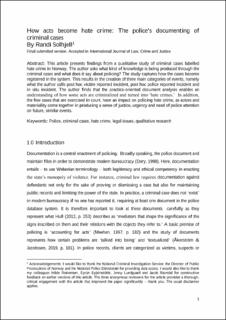How acts become hate crime: The police's documenting of criminal cases
| dc.contributor.author | Solhjell, Randi | |
| dc.coverage.spatial | Norway | en_US |
| dc.date.accessioned | 2023-01-10T06:56:31Z | |
| dc.date.available | 2023-01-10T06:56:31Z | |
| dc.date.issued | 2023 | |
| dc.identifier.issn | 1876-763X | |
| dc.identifier.uri | https://hdl.handle.net/11250/3042122 | |
| dc.description.abstract | This article presents findings from a qualitative study of criminal cases labelled hate crime in Norway. The author asks what kind of knowledge is being produced through the criminal cases and what does it say about policing? The study captures how the cases become registered in the system. This results in the creation of three main categories of events, namely what the author calls post hoc victim reported incident, post hoc police reported incident and in situ incident. The author finds that the practice-oriented document analysis enables an understanding of how some acts are criminalized and turned into ‘hate crimes.’ In addition, the few cases that are exercised in court, have an impact on policing hate crime, as actors and materiality come together in producing a sense of justice, urgency and need of police attention on future, similar events. | en_US |
| dc.language.iso | eng | en_US |
| dc.publisher | Science Direct | en_US |
| dc.subject | police | en_US |
| dc.subject | politi | en_US |
| dc.subject | criminal cases | en_US |
| dc.subject | straffesaker | en_US |
| dc.subject | hate crime | en_US |
| dc.subject | hatkriminalitet | en_US |
| dc.subject | legal issues | en_US |
| dc.subject | juss | en_US |
| dc.subject | qualitative research | en_US |
| dc.subject | kvalitativ metode | en_US |
| dc.subject | forskning | en_US |
| dc.title | How acts become hate crime: The police's documenting of criminal cases | en_US |
| dc.type | Peer reviewed | en_US |
| dc.type | Journal article | en_US |
| dc.description.version | acceptedVersion | en_US |
| dc.source.volume | 72 | en_US |
| dc.source.journal | International Journal of Law, Crime and Justice | en_US |
| dc.source.issue | March 2023 | en_US |
| dc.identifier.doi | https://doi.org/10.1016/j.ijlcj.2022.100574 |
